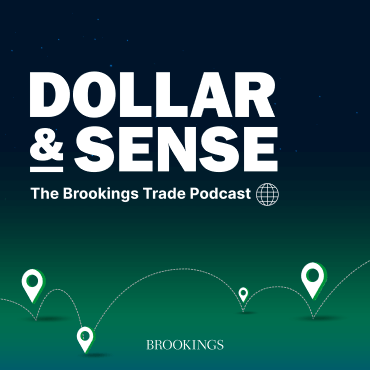While the United States has made great strides in vaccinating its population, many low- and middle-income countries are far behind and lack the supply of COVID-19 vaccines they need. Matthew M. Kavanagh joins David Dollar in this episode to explain what could be done to increase the global production of vaccines, including a proposal to waive the World Trade Organization rules protecting the intellectual property for vaccine technology.
Related content:
To Democratize Vaccine Access, Democratize Production
Why intellectual property and pandemics don’t mix
This transcript has been lightly edited.
DAVID DOLLAR: Hi, I’m David Dollar, host of the Brookings trade podcast Dollar & Sense. The theme this week is vaccines, specifically vaccinating the whole world population against the COVID-19 virus. My guest is Matthew Kavanagh, director of the Global Health Policy and Politics Initiative at the O’Neill Institute at Georgetown University. Welcome to the show, Matthew.
MATTHEW KAVANAGH: Thanks so much for having me.
DOLLAR: So the U.S. is making impressive progress now with vaccinating our population. What’s the picture in the rest of the world, particularly in developing countries in the poor part of the world?
KAVANAGH: So the news is really not very good. Here in the United States, we have actually passed more than half of people have been fully vaccinated at this point, which is hugely good news. But around the world, we are facing far less success.
So in low-income countries, they’ve gotten just 0.4 percent of all the vaccines that have gone into people’s arms around the world, and it’s really becoming a problem. Africa, for example, has only about maybe 25 percent of the vaccines that it would need to reach even just its seniors and its health care workers—these priority populations. Most countries have only around 25 percent of what they need there.
In South Asia, you are looking at—probably they have got a little bit more vaccine, but still it’s under 10 or 15 percent of the population in most countries that are able to be covered by the amount of vaccines they have. So really, we’ve got a huge supply problem and a bottleneck where the vaccines are not getting even close to equitably distributed to the countries that need them.
DOLLAR: So it’s amazing that we have developed these vaccines relatively quickly. India and South Africa have proposed that we waive the patents on the vaccines so that they can be produced and quickly distributed around the world. What’s the argument in favor of waiving the patents?
KAVANAGH: So the idea here is that, as you say, the science has been amazing. It is truly a marvel that within a year we have gone from no vaccines and a brand new virus that we were not prepared for to, in a year, multiple effective vaccines. Of course, this took decades of research; this did not actually happen in a year. It’s been years and years of scientists working on this from a variety of different perspectives. But this last bit of work we have seen incentivized by huge investments by governments that were able to bring forth—after billions of dollars and a ton of political effort—were able to really bring forth remarkable vaccines.
The problem, though, is that these vaccines are currently almost exclusively—especially the very best of the vaccines—they are under monopolies. So you have a handful of companies that are really the ones allocating who is going to get the vaccines and who is not in terms of the global landscape. And what is clearly true right now is that we have a supply crisis. We’ve got far more people who need the vaccine than we have production of those vaccines, and the core of that is because there’s only a handful of companies that are making the vaccines right now.
So right now in India, for example, there’s really just one or two companies that are making vaccines under an exclusive license. The Serum Institute of India, for example, is making the AstraZeneca vaccine under license. They are the only ones allowed do so. The Biological E. is making the Johnson & Johnson vaccine. But again, they are the only ones able to do it. And these two companies are basically some of only a handful of companies authorized in the entire world to actually make the vaccines. In South Africa, there’s nobody really licensed; there’s one kind of potential licensee coming on. In most countries of the world, there’s almost none.
What we have seen when it comes to pharmaceuticals is that there’s huge capacity worldwide to be able to make products. And the originator companies often say, “no, no, we are the only ones who can make these products.” But in fact, what we find is that when others are allowed to do so—India, for example, has powerhouse companies. Companies, like Cipla, that are billion-dollar companies. Huge production capacity, high, high quality. Why aren’t they making the vaccines too? The same is true in Brazil, in Vietnam, in Bangladesh, in South Africa, in Senegal. These are really fantastic companies that could be making the vaccines.
The problem is that they are missing two core pieces. They are missing the know-how and they are missing the right to make the vaccines. So far, despite all of the efforts by the World Health Organization and others to try to get the companies to just share their know-how, so far they haven’t done so. So the idea of the patent waiver is to say, look, writ large, what we need is to get these vaccines produced in as many different places as possible. We need to mobilize all the capacities that we can so that we are making vaccines worldwide. One of the barriers to that is the patents. But it’s not just patents, it’s also the kind of broader intellectual property which includes trade secrets.
The Brookings Institution is committed to quality, independence, and impact.
We are supported by a diverse array of funders. In line with our values and policies, each Brookings publication represents the sole views of its author(s).






Commentary
PodcastWe are a long way from vaccinating the world. Could a patent waiver help?
June 7, 2021
Listen on
Dollar and Sense Podcast